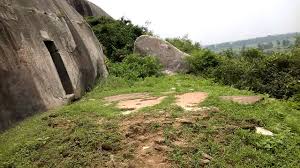The Oldest Surviving Rock-cut Caves:
Barabar & Nagarjuni of Bihar India
Rock-cut caves have been very unique in themselves. They are spread over all over India and are found in other countries of the world also. But rock-cut caves located in Makhdumpur Block of Jehanbad district of Bihar India almost 24 km north of Gaya are very very special and amazing.
The Barabar and Nagarjuni caves are the oldest surviving rock-cut caves mostly dating from the Maurya Empire (322-185 BC), some with Ashoka inscriptions.
 Image Courtesy: youtube.com
Image Courtesy: youtube.com
These caves are situated in the twin hills of Barabar with four caves and Nagarjuni with three caves separated by 1.6 km. These rock-cut chambers were built by Ashoka and his grandson Dasharatha of Maurya dynasty.
| Image courtesy:buddhistcircuitbihar.com |
The caves were made for ascetics from Ajivika sect, founded by Makkhali Gosala , a contemporary of Gautam Buddha, the founder of Buddhism, and of Mahavira, the founder of Jainism.
Most caves at Barabar have two chambers, carved entirely of granite, with a highly polished internal surface, and with exciting, amazing echo effects.
Caves at Barabar Hills:
1. Lomas Rishi Cave
2. Sudama Cave
3. Karan Chaupa
4. Visva Zopri
Caves at Nagarjuna Hills:
1. Gopi (Gopi-ka-kubha)
2. Vadithi- ka - kubha cave
3. Vapiya-ka-kubha cave
2. Sudama Cave
3. Karan Chaupa
4. Visva Zopri
Caves at Nagarjuna Hills:
1. Gopi (Gopi-ka-kubha)
2. Vadithi- ka - kubha cave
3. Vapiya-ka-kubha cave
